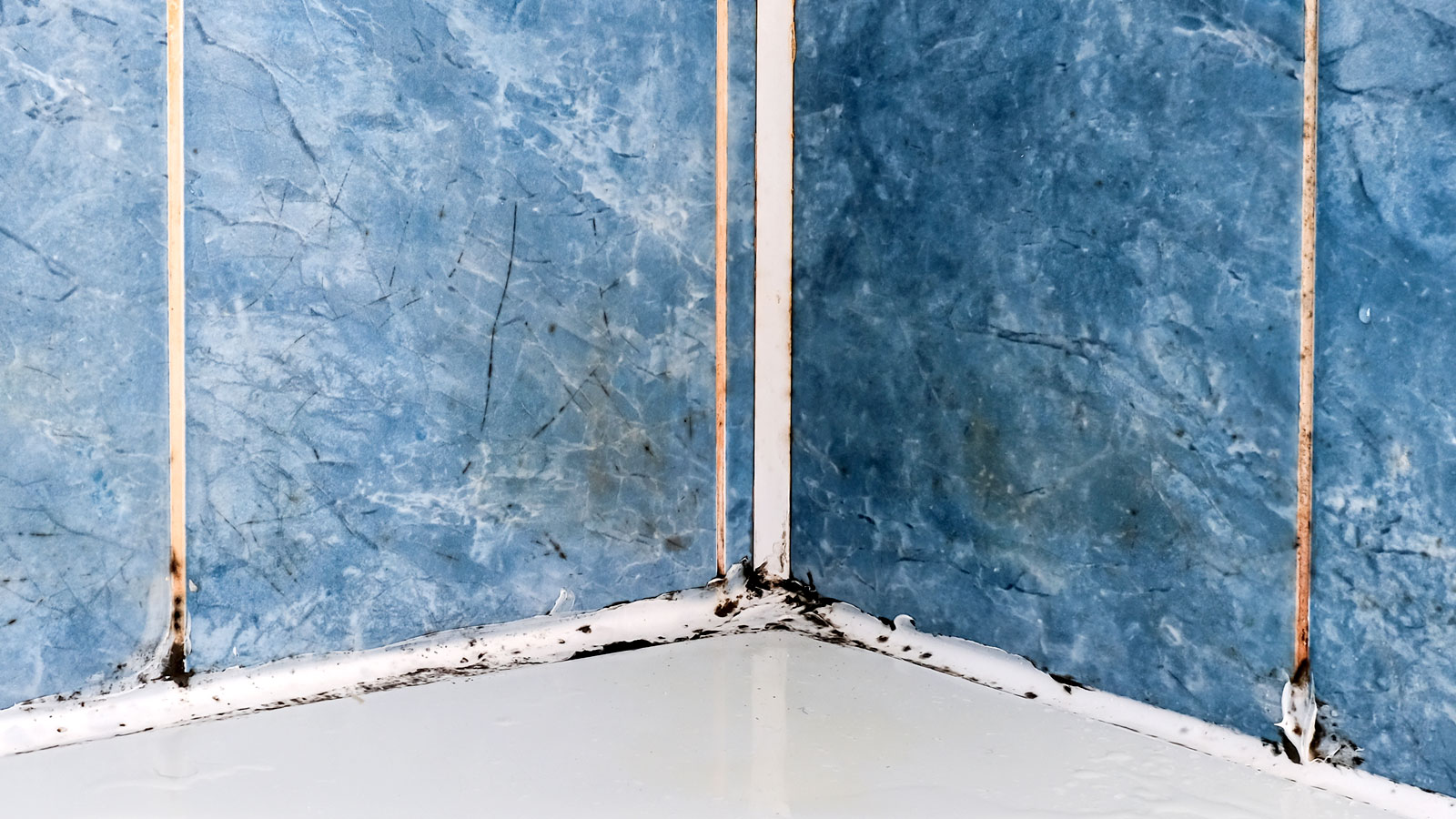How to get rid of black mould in bathrooms
Black mould in bathrooms is ugly and unhealthy. Here we get expert advice on the causes, how you can get rid of it, and stop it coming back

When you see black mould in bathrooms you know it's time to take action. Not only does it spoil the aesthetic of your bathroom, it's not good for your health. Leave it to fester and it will only get worse and more difficult to get rid of.
Black mould needs to be eradicated as soon as possible. There are a few methods for removing mould from ceilings, walls, wood, tile and grout, that can kill it off permanently. But if the underlying issue isn’t tackled the mould will eventually reappear. Follow this guide to make sure that doesn't happen.
Causes of black mould in bathrooms
“Factors such as wet and humid weather conditions, a lack of proper home heating, your shower and bath, smoking and even your own breath can contribute to a build up of moisture that results in damp and humid conditions.” explains Nancy Emery, cleaning expert at Drench.
The problem is heightened in a bathroom, continues Emery, “Bathrooms are particularly at risk as the moisture builds up faster than it can leave.” Hot showers or baths quickly mix with cold air and create condensation, and the longer it takes to disperse the more damage it can do.
Health implications of black mould
Black mould in bathrooms can be bad for your health.
“The fungus that develops as a result can be unpleasant to look at whilst also being harmful to your health.” reveals Emery. “Regardless of whether you and your family have allergies, mould can cause you to develop allergic reactions, asthma, eczema and other lung conditions just from being exposed.”
Another good reason to deal with black mould quickly.
How to get rid of black mould in bathrooms
There are a few different options to help get rid of black mould. Emery suggests that the following three methods are the most effective.
1. Use a mould spray
Using an anti-mould spray, like this HG Mould Spray from Amazon, or solution can work to eliminate mould. Apply the solution to the areas affected and a few inches around. Scrub with a strong bristle brush, following the instructions on the bottle. For tighter spaces, you can also use an old toothbrush. Once done, rinse thoroughly and then dry with a clean cloth.
2. Spray with vinegar
Vinegar is an inexpensive way to target mould. Mix up a solution of 2 parts vinegar to one part water into an empty spray bottle and apply to the affected areas. Leave for 30 minutes to an hour before wiping with a damp cloth. Once this is done, be sure to allow the area to dry completely.
3. Blast with bleach
To avoid overspending on sprays, bleach is a cheaper alternative that will ensure mould spores are blasted away. Make sure the windows are open and the room is properly ventilated before you begin, and always wear gloves and a mask.
You can apply the bleach directly to the affected areas and wait around an hour. You should see the mould disappear. Then you can rinse away thoroughly before drying with a clean cloth.
Alternatively, mix some dish soap and water together and wash the area with a sponge in circular motions, wiping clean with fresh water. Then apply a solution of bleach and warm water to the mould patches with a clean sponge. Let this sit for around 5 minutes, before washing away with warm water and patting dry with a clean cloth.
Black mould on sealants
When bathroom sealant is constantly exposed to water or moisture and doesn’t dry out properly mould can start to form. Typically, the sealant has been compromised – meaning the edges are starting to lift away from the surface – and moisture is getting underneath the sealant. Moisture gets trapped under the edges and black mould can start to grow.
Poorly applied sealant is a common cause of black mould. When sealing a bath or sink the area where the sealant is applied needs to be free of soap residue, grease, dust etc. Otherwise, it won’t create a watertight bond, providing a scenario suitable for black mould to grow.
There are a number of different methods that can work to help remove black mould from silicone sealant and give it a fresh look and pleasant smell. These are very similar to the methods mentioned previously.
We recommended a mixture of baking soda and warm water applied with a toothbrush as an effective natural cleaner. However, if the sealant in your bathroom is beyond saving the best thing to do is to replace it with one of the best bathroom sealants on the market. Don’t forget to make sure that the surface the sealant is being applied to is clean and dry.
It is worth knowing that vinegar is effectively acetic acid in water so using vinegar as a sealant cleaner can damage sealant if used regularly. But in reality, the amount of acetic acid used in vinegar is nominal and will have little effect on the sealant.
Preventing black mould returning
If your bathroom is trapping moisture in the air, you need to get rid of it to help stop it coming back. Opening windows to ventilate is an easy option, but not such a popular choice in the middle of winter.
A good alternative is to choose one of the best bathroom extractor fans. Set it up so it comes on every time the light is switched on or purchase a fan with an adjustable humidity sensor that automatically switches on when there is too much humidity in the air.
If water is pooling in certain spots i.e. bath edges against walls, corner of shower trays, wipe away the water and dry the area with a cloth/towel. Keeping it water free will help stop mould forming.
Painting over black mould in bathrooms
Bathrooms can produce a lot of humidity and warmth, which promotes the growth of black mould on walls, especially in corners, at the top of walls and ceilings. Before you can paint, removing mould from walls is an essential part of the process.
The affected areas will need to be left to dry out. Leave windows open, and/or, introduce one of the best dehumidifiers to help remove moisture. When dry, use a mould resistant paint like this Zinsser PermaWhite paint from Amazon or this Dulux Easycare Bathroom paint from B&Q. Both have mould inhibitors in them to help keep away black mould.
Mould in a bathroom can get everywhere. Check out our how to remove mould from grout and mould on skirting boards guides to restore both to their former glory.
Get the Homebuilding & Renovating Newsletter
Bring your dream home to life with expert advice, how to guides and design inspiration. Sign up for our newsletter and get two free tickets to a Homebuilding & Renovating Show near you.
Steve Jenkins is a freelance content creator with over two decades of experience working in digital and print and was previously the DIY content editor for Homebuilding & Renovating.
He is a keen DIYer with over 20 years of experience in transforming and renovating the many homes he has lived in. He specialises in painting and decorating, but has a wide range of skills gleaned from working in the building trade for around 10 years and spending time at night school learning how to plaster and plumb.
He has fitted kitchens, tiled bathrooms and kitchens, laid many floors, built partition walls, plastered walls, plumbed in bathrooms, worked on loft conversions and much more. And when he's not sure how to tackle a DIY project he has a wide network of friends – including plumbers, gas engineers, tilers, carpenters, painters and decorators, electricians and builders – in the trade to call upon.

